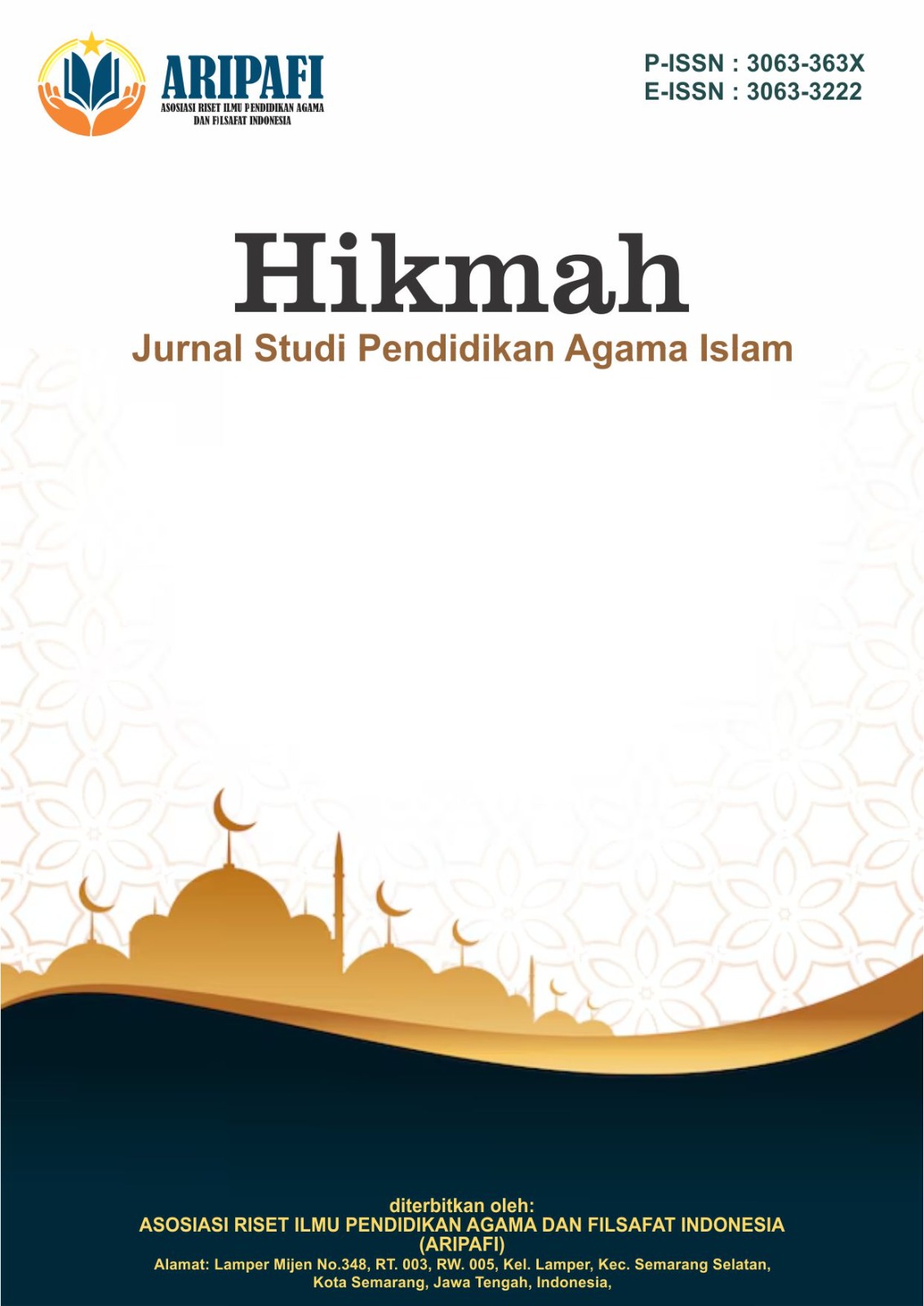Pengaruh Penggunaan Metode Istiqroiyyah dalam Pembelajaran Shorof Bab Fi'il Tsulatsi Mazid Terhadap Siswa Kelas 8 SMPS Daar El-Falah
DOI:
https://doi.org/10.61132/hikmah.v2i1.503Keywords:
Istiqroiyah Method, Fi'il Tsulasi Mazid, Shorof LearningAbstract
Shorof learning among madrasa students has a very vital role in understanding Arabic writing, including the Al-Qur'an which uses this language. This research aims to investigate the effect of using the istiqroiyyah method in learning shorof, especially in the fi'il tsulatsi mazid chapter. In this research, we carried out a series of learning activities involving various istiqroiyyah methodological approaches, such as games, explanations through stories, and writing examples on the blackboard alternately. We involved 8th grade students and female students at a modern Islamic boarding school, who were divided into two groups: the first group received learning using traditional methods, while the second group used the istiqroiyyah method. The focus of this analysis is the development of students' understanding of the discussion of Fi'il Tsulatsi Mazid in Shorof. The research results showed that the group taught using the istiqroiyyah method experienced a significant increase in their understanding of this chapter, as well as motivating them to continue learning better in the future. These findings emphasize the importance of using the istiqroiyyah method in learning shorof fi'il tsulatsi mazid. The pedagogical implications of this research encourage the need for innovative approaches in teaching shorof science to santri. Thus, the results of this research can be the basis for developing a more effective Arabic language curriculum for students.
References
Abdullah, K., Misbahul Jannah, M. Pd., Ummul Aiman, S. Pd., Suryadin Hasda, dkk. (n.d.). Metodologi penelitian kuantitatif.
Agustin, F. R. (2023). Metode pembelajaran maharah qiro’ah pada mahasiswa. Intelektualita, 12(2).
Fauziah, H., & Amelia, R. (2022). Pengaruh penerapan metode muraja’ah pada pembelajaran tahfidz al-Qur’an terhadap keberhasilan menghafal al-Qur’an (Juz 30) siswa kelas VI di MI Rohmaniyah Sukawening Garut. Masagi, 1(1), 212–218.
Huda, M. M., Sutomo, M., & Mashudi, M. (2023). Implementasi metode mind mapping dalam pembelajaran nahwu pada bab fail menggunakan powerpoint di kelas III Ibtida Madrasah Diniyyah Al-Hikmah Kesilir Wuluhan Jember. FAJAR Jurnal Pendidikan Islam, 3(1), 1–18.
Khoiri, K. (n.d.). Studi komparatif metode qiyasiyah dan istiqroiyah dalam pembelajaran nahwu di pondok pesantren.
Maulana, R. A. (n.d.). Efektivitas pembelajaran bahasa Arab dalam mengetahui kedudukan kalimat menggunakan metode al-Miftah lil ‘Ulum pada siswa kelas VIII Pondok Pesantren Darul Ihsan Sukoharjo Jawa Tengah.
Muliatno. (2023). Nahwu shorof teaching method in learning Arabic. Edumaniora: Jurnal Pendidikan Dan Humaniora, 2(01), 1–4.
Nashrulloh, M. M., & Fauji, I. (n.d.). Analysis of fiil tsulasi mazid in Surat Az-Zukhruf and its implications in Sharaf learning [Analisis fiil tsulasi mazid dalam Surat Az-Zukhruf serta implikasinya dalam pembelajaran sharaf].
Nf, M. S. (n.d.). Mendalami sharaf, menyelami perubahan kata dan maknanya.
Nugraha, S. A., & Anggarini, I. F. (2023). Penerapan metode ‘At-Tathbiqoh’ (aplikatif) shorof dan nahwu pada santri usia dini di Pondok Pesantren PPQK Al-Hasani. Cokroaminoto Journal of Primary Education, 6(2), 105–118.
Putri, N. A. A., & Zulkarnaen, R. C. (2024). Pengaruh media kartu kosakata (Bithoqoh Al-Mufrodat) dalam pembelajaran bahasa Arab terhadap siswa kelas 2 MI Darul Hikmah Tangerang. Desember.
Rajak, A. (n.d.). Metodologi pembelajaran bahasa Arab di madrasah.
Ritonga, M. H. (2022). Sukses belajar ilmu shorof. Merdeka Kreasi Group.
Rohayati, E., Wasilah, W., & Rahmadewi, S. (2024). [No title found]. Tapis: Jurnal Penelitian Ilmiah, 8(1), 49.
Saputri, N. (2023). Pengaruh penggunaan metode kreatif dalam pembelajaran keislaman pada anak usia dini. Jurnal Al Athfaal, 1(1), 40–50.






